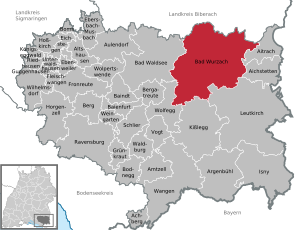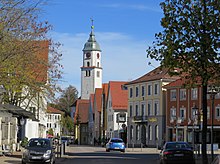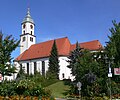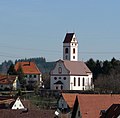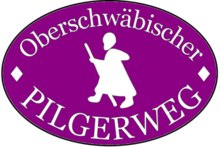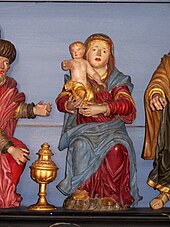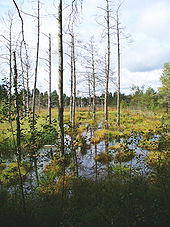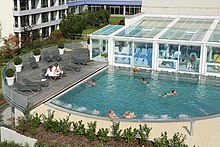Bad Wurzach
| coat of arms | Germany map | |
|---|---|---|
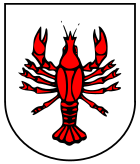
|
Coordinates: 47 ° 55 ' N , 9 ° 54' E |
|
| Basic data | ||
| State : | Baden-Württemberg | |
| Administrative region : | Tübingen | |
| County : | Ravensburg | |
| Height : | 654 m above sea level NHN | |
| Area : | 182.26 km 2 | |
| Residents: | 14,651 (Dec. 31, 2018) | |
| Population density : | 80 inhabitants per km 2 | |
| Postal code : | 88410 | |
| Primaries : | 07564, 07527 , 07568 | |
| License plate : | RV, SLG , ÜB , WG | |
| Community key : | 08 4 36 010 | |
| LOCODE : | DE BWZ | |
City administration address : |
Marktstrasse 16 88410 Bad Wurzach |
|
| Website : | ||
| Mayoress : | Alexandra Scherer | |
| Location of the city of Bad Wurzach in the Ravensburg district | ||
Bad Wurzach (until 1950 Wurzach ) is a small spa town in Upper Swabia and the oldest mud spa in Baden-Württemberg . In terms of area, Bad Wurzach is the third largest municipality in the state after Stuttgart and Baiersbronn and, for example, larger than the Principality of Liechtenstein .
geography
Bad Wurzach is located in a wide valley between the Allgäu and Upper Swabia on the edge of the Wurzacher Ried at an altitude of 650 to 800 meters.
City structure
The city of Bad Wurzach consists of the districts
- Bad Wurzach (5383 inhabitants )
- Arnach (1373)
- Dietmanns (794)
- Eintürnen (with Eintürnenberg) (814)
- Gospoldshofen (609)
- Haidgau (1019)
- Hauerz (1097)
- Seibranz (1213)
- Unterschwarzach (1285)
- Ziegelbach (926)
Neighboring communities
The city borders two communities in the Biberach district and two cities and four communities in the Ravensburg district . These are, starting in the north, clockwise: Eberhardzell and Rot an der Rot in the Biberach district as well as Aitrach , Aichstetten , Leutkirch im Allgäu , Kißlegg , Wolfegg and Bad Waldsee in the Ravensburg district.
history
Until the 19th century
The place was first mentioned in a document on June 13, 1273 as "Oppidum Wurzun". On May 27, 1333, Emperor Ludwig awarded the Bavarian Hans Truchsess von Waldburg the Memmingen town charter for the "town of Wurzun" (with the town charter, Wurzach received the rights of lower jurisdiction, market rights and the right and duty of walling). In 1514 the canvas show (examination) was set up. The construction of the Maria Rosengarten women's monastery began in 1515. On April 14, 1525, the battle of the Leprosenberg in Wurzach took place during the Peasants' War . In 1637 only 19 citizens lived in Wurzach due to the effects of the Thirty Years War and epidemics. In 1675 the dominion of Waldburg-Zeil -Wurzach was established. In order to expand the community, which still had no more than 100 inhabitants in 1780, Count Eberhard Ernst encouraged the influx of new citizens, especially traders, through special privileges. In 1806 the rule of Wurzach came to the Kingdom of Württemberg and was initially assigned to the Oberamt Waldsee and from 1810 to the Oberamt Leutkirch . In 1813 and 1814 a total of 35,301 soldiers were fed during the War of Liberation in Wurzach, the leprosy house served as a hospital for 4,003 men. Sixteen soldiers died while staying at the leper house.
An additional princely office was not until 1849, in which the Württemberg State the prince of Waldburg-Zeil-Wurzach special civil magnificent conceded administrative rights on the ground. This right was revoked after the conclusion of the March Revolution .
20th and 21st centuries
In 1903 the lordly line Waldburg – Zeil – Wurzach went out.
In 1904 the Roßberg – Wurzach railway was opened. From 1936 the first mud baths were released in Maria Rosengarten. With the dissolution of the Oberamt Leutkirch from 1806 to 1934, then the district of Leutkirch from 1934 to 1938, during the administrative reform during the Nazi era in Württemberg , the city came to the district of Wangen in 1938 .
In 1945 the place became part of the French occupation zone and was thus assigned to the newly founded state of Württemberg-Hohenzollern in 1947 , which became part of the state of Baden-Württemberg in 1952.
After the dissolution of the Catholic seminary, the Wurzach Castle was used as a prisoner of war camp for French officers from the beginning of the Second World War. After the occupation of the British Channel Islands, civilians from there were housed in the castle as internees until the end of the war. In the first years after the war there was little contact between the former deportees to Upper Swabia. In 1970 the first group of visitors came to Wurzach on the 25th anniversary of the liberation. Since then there have been many encounters, in 2002 there was a town twinning between Saint Helier and Wurzach.
In 1936 the spa business was started and in 1950 the place was given the title bath . With the municipal reform in 1972, the districts named in the city structure were incorporated into the city of Bad Wurzach. In 1973 it was assigned to the Ravensburg district. Since 1996 the place has been extensively restored and renewed as part of the urban redevelopment.
Incorporations
In the course of the municipal reform in Baden-Württemberg , the following previously independent municipalities were incorporated into Bad Wurzach:
- June 1, 1972: Arnach , Eintürnen and Ziegelbach
- July 1, 1972: Hauerz
- December 1, 1972: Gospoldshofen
- January 1, 1973: Dietmanns and Haidgau
- January 1, 1975: Seibranz and Unterschwarzach
Haidgau was part of the Ravensburg district even before the district reform . Unterschwarzach and Dietmanns belonged to the district of Biberach , the other communities belonged to the district of Wangen .
History of the districts

|
Arnach: around 950, a donation document mentions a knight Berngarius de Arnanc . Until 1806, tithe was paid to the Wolfegg Collegiate Foundation, after which it was mediated to the Prince of Waldburg-Wolfegg-Waldsee. From 1806 to 1934 it was an independent municipality of the Oberamt Waldsee , and then from 1934 to 1938 district Waldsee, then until 1972 of the district Wangen |

|
Dietmanns, formerly part of the Wolfegg county, which belonged to the Oberamt Waldsee from 1806 to 1934 and was then affiliated to the Waldsee district from 1934 to 1938 and then to the Biberach district until 1972. |

|
Eintürnen, belonging to the county of Wolfegg since around 1500 and from 1824 to 1934 to an independent municipality of the Oberamt Waldsee and then from 1934 to 1938 to the district of Waldsee, which from 1938 belonged to the district of Wangen |

|
Gospoldshofen, separated from the municipality of Wurzach from 1823 to 1934 and made an independent municipality of the Oberamt Leutkirch , and then from 1934 to 1938 as a village raised to the district of Leutkirch. In 1938 it came to the district of Wangen |

|
Haidgau, formerly also spelled Heidgau, belonged to the Wolfegg county. It was first mentioned in 797 in a document from the Sankt Gallen monastery. From 1806 to 1934 it was an independent municipality in the Oberamt Waldsee , then from 1934 to 1938 in the Waldsee district, then in the Ravensburg district |

|
Hauerz: The landlord was once the Prince of Waldburg zu Zeil-Wurzach. From 1806 to 1934 Hauerz became an independent municipality of the Leutkirch Regional Office , and then from 1934 to 1938 in the Leutkirch district and in 1938 in the Wangen district |

|
Seibranz, once for the most part owed a ten-year fee to the Prince of Waldburg-Zeil. From 1806 to 1934 the municipality of the Leutkirch Regional Office , then from 1934 to 1938 the Leutkirch district, then the Wangen district |

|
Unterschwarzach, a small parish village that once belonged to the Counts of Waldburg-Wolfegg-Waldsee, from 1806 to 1934 a municipality of the Waldsee District Office , then from 1934 to 1938 in the Waldsee district, then until 1972 in the Biberach district |

|
Ziegelbach, once part of the Wolfegg county, from 1806 to 1934 municipality in the Oberamt Waldsee , then from 1934 to 1938 in the Waldsee district, then since 1938 in the Ravensburg district. |
See also Oberamt Waldsee and Leutkirch , both full text in Wikisource.
Religions
70% of the residents of Bad Wurzach are Catholic, 8% Protestant.
The Catholic pastoral care unit Bad Wurzach in the diocese of Rottenburg-Stuttgart includes the parishes St. Verena (Bad Wurzach) , St. Ulrich and St. Margaretha (Arnach), St. Ulrich and Margareta (Dietmanns), St. Jakobus (Eggmannsried) , St. Martin (Eintürnenberg) , St. Nikolaus (Haidgau) , St. Martin (Hauerz) , St. Ulrich (Seibranz) , St. Gallus (Unterschwarzach) and Our Lady (Ziegelbach) .
The Roman Catholic Carthusian Order operates a monastery in Bad Wurzach with the Marienau Charterhouse .
politics
Municipal council
The local elections on May 26, 2019 brought the following result:
mayor
In the mayoral election on April 22, 2018, 11,304 eligible voters cast 5,919 valid votes. This corresponded to a turnout of 52.6%. Alexandra Scherer was elected mayor from a total of five applicants with 78.7% of the valid votes.
coat of arms
The Bad Wurzach city arms show a crayfish . According to legend, this animal, which was native to the Wurzacher Ach at the time, must have liked the residents so much that it was adopted as the heraldic animal .
Town twinning
The city maintains partnerships with:
- Luxeuil-les-Bains in the southern Vosges in France (since 1988)
- Wallingford in the English county of Oxfordshire, Great Britain (since 2000)
- Popielów in the Opole Voivodeship in Poland (since 2000)
- Saint Helier on the Channel Island of Jersey (since 2002)
Culture and sights
Tourist bike and hiking trails
The Oberschwäbische Barockstraße and the Schwäbische Bäderstraße run through Bad Wurzach. The Upper Swabian Pilgrimage Route also runs through the city on loop 4.
Bike paths
- Bad Wurzach has five signposted bike tours in and around Bad Wurzach
- Remote bike paths such as the Swabian spa cycle path , the cycle track Oberschwaben-Allgäu , the Rotradweg and Radrunde Allgäu also lead through the city.
Hiking trails
- 18 hiking tours from easy to challenging lead through the area around Bad Wurzach and around the European certified Wurzacher Ried.
- Bad Wurzach is also on the meadow walker route, one of three routes in the Allgäu hiking trilogy . Bad Wurzach is a portal location of the Allgäu hiking trilogy for the themed area natural treasure chamber.
Museums
- Leprosenhaus , former leprosarium , birthplace of the painter Sepp Mahler , museum on the history of the house and Sepp Mahler gallery.
- The cheese dairy museum of the Vogler dairy shows how cheese was produced in the Allgäu a hundred years ago and in the 1930s. In order to finance the museum, the so-called “cheese share” was issued as a pleasure certificate.
- Upper Swabian Peat Museum with educational trail "In the footsteps of the peat cutters"
- Torfbahn in Wurzacher Ried : Special trips with the field train (600 mm gauge ) from the Zeiler Torfwerk (directly on the federal highway 465 ) to the Torfwerk Haidgau take place every second and fourth Sunday of the month.
- "Moor Extreme", exhibition in the nature conservation center
Buildings
- Bad Wurzach Castle , a former Waldburg castle with an important Baroque staircase from 1728
- Former monastery "Maria Rosengarten" with rococo house chapel from 1763
- Salvatorian Monastery Gottesberg , Monastery of the Salvatorian Order on the Gottesberg above the city
- Catholic parish church of St. Verena , early classical church from 1775–1777
- Gottesberg , pilgrimage church from 1709; Holy blood relic; Horse procession " Blutritt " on the second Friday in July.
- Marienau Charterhouse , the only Carthusian monastery in Germany. The Charterhouse cannot be visited.
- Former leper house (see museums)
There are 43 chapels in the urban area of Bad Wurzach.
Natural monuments
- The Wurzacher Ried nature reserve is one of the largest intact raised bog areas in Europe. The peat extraction was completely stopped in 1997.
- Wachbühl , 791 meter high panoramic and hiking mountain
Friedrich Schiedel Prize for Literature
The city of Bad Wurzach has awarded the Friedrich Schiedel Literature Prize every two years since 1983, which goes back to the entrepreneur Friedrich Schiedel , who was born in Baierz in 1913 . The event takes place in the Kursaal of the Kurhaus Bad Wurzach.
Leisure and sports facilities
- Vitalium thermal baths, thermal baths with saunas
- Indoor swimming pool
- Outdoor swimming pool in Hauerz
- 180 km of cycling and hiking trails
- Allgäu hiking trilogy and Allgäu cycle tour
- Skater place
- Several sports fields, including an artificial turf field
Economy and Infrastructure
traffic
Bad Wurzach is on the B 465 ( Kirchheim unter Teck - Leutkirch im Allgäu ). The city is with some bus routes u. a. connected to Bad Waldsee , Aulendorf , Kißlegg , Biberach an der Riss , and Leutkirch and belongs to the Bodensee-Oberschwaben Verkehrsverbund (bodo) .
The Roßberg – Bad Wurzach line was opened in 1904 as a branch line of the Württemberg Allgäu Railway. The Deutsche Bundesbahn gave up passenger transport on September 29, 1963. After it was shut down by Deutsche Bahn in 2002 , the city of Bad Wurzach bought the freight line on October 1, 2004 and has since acted as the railway infrastructure company for the line. Freight traffic on the Roßbergbahn was taken over in 2003 by Bayerische Cargo-Bahn GmbH (a former subsidiary of Captrain Germany ). From 2012 Stock-Transport GmbH carried out the delivery of quartz sand and soda from the Rhineland for the Bad Wurzach-based glass factory until this traffic was shifted to the road at the end of 2016. Since July 2010, passenger trains have been running on selected Sundays and public holidays between May and October as "Radexpress Oberschwaben" on the Aulendorf - Bad Waldsee - Roßberg route (only operating stop) - Bad Wurzach.
Established businesses
The largest employer is the glass factory Verallia Deutschland AG (until 2016: Saint-Gobain Oberland AG ). The company (today this is also the headquarters of the German headquarters) was founded in 1946 as Oberland Glas GmbH . The four plants in Germany produce under the name of the French parent company Saint-Gobain . A form of agriculture typical of the landscape, but now a rare business, is the shepherd's cooperative Finkhof, which has been self-governing for decades.
Educational institutions
In urban sponsorship are two all-day schools, the primary school Bad Wurzach and Werkrealschule Bad Wurzach. In addition, there is a special school and a secondary school in the city. There are six more elementary schools in the suburbs. The private high school Salvatorkolleg is also located in the urban area . There are six Roman Catholic and five municipal kindergartens .
Health resort
Bad Wurzach is considered to be the oldest mud spa in Baden-Württemberg, it has existed since 1936 and is one of the few with a thermal spring. At the beginning, the first mud baths for the treatment of chronic diseases of the musculoskeletal system were offered in the Maria Rosengarten monastery in Wurzach , initially only to women, a year later also to men. This first spa facility was run by the Order of Poor School Sisters . The moor treatments became more and more popular because of their healing properties; By 1942, 7,000 mud baths had been given to 2,800 guests.
Due to capacity problems and increasing demand for mud baths, the Wurzach municipal spa was founded in 1948 and the Kurmittelhaus opened in Parkstrasse. As a result, the city quickly grew into an important health resort. In 1950 Wurzach was given the rating bath, which in Germany only officially recognized spas are allowed to wear. In 1968 this cure center became too small, which is why the cure center was built on Reischberg. In 1977 the spa hotel on Reischberg was opened.
In 1999 the tourist health and recreational offer was expanded with the opening of the Vitalium Therme. In 2007 the thermal bath was rebuilt and expanded to include an outdoor thermal water pool, a sauna area and a "feel-good house" for wellness treatments. Since then, the thermal bath has had the health center with the connected Vitalium thermal bath, wellness area, sauna area and fitness studio, as well as the spa hotel on the Reischberg.
The entire spa operation is run by the city of Bad Wurzach as its own . The health resort administration is responsible for the central administration of the business.
Personalities
sons and daughters of the town
- Eustachius Gabriel (1724–1772), Baroque painter
- Franz Xaver Schnizer (1740–1785), composer and organist
- Ferdinand Eggmann (1827–1913), clergyman and politician
- Eberhard II of Waldburg-Zeil-Wurzach (1828–1903), from 1865 to 1903 fourth prince of Waldburg-Zeil-Wurzach
- Paul Eduard Waldraff (1870–1917), graphic artist and postage stamp artist
- Clemens Högg (1880–1945), SPD politician, MdL in Bavaria
- Oskar Graf (1882–1942), politician, member of the Baden state parliament
- Sepp Mahler (1901–1975), painter and vagabond
- Carl Joseph Leiprecht (1903–1981), Bishop of Rottenburg-Stuttgart
- Friedrich Schiedel (1913–2001), entrepreneur and patron
- Arsenius Butscher (1928–2013), motorcycle racer
- Peter Schad (* 1952), founder of the band Oberschwäbische Dorfmusikanten
- Herbert Eichhorn (* 1957), art historian
- Gerd Riss (* 1965), eleven times motorcycle world champion (Speedway)
People who worked on site
- Johann Nepomuk von Kolb (1726–1799), German Roman Catholic theologian and parish priest of Wurzach
- Father Agnellus Schneider (1913–2007), writer and environmentalist, lived and worked in Bad Wurzach and fought for the preservation of the Wurzacher Ried
- Heiko Butscher (* 1980), former soccer player, grew up in the Dietmanns district and began his career at SV Dietmanns
literature
- Otto Beck: The Gottesberg in Bad Wurzach (= Small Art Guide 1775, ZDB -ID 51387-8 ). Schnell & Steiner, Munich a. a. 1989.
- Hans-Peter Biege: Italian heaven over the cure. Bad Wurzach has been offering its guests the moor for seventy years. In: Wolfgang Niess, Sönke Lorenz (ed.): Cult baths and bath culture in Baden-Württemberg. Markstein-Verlag, Filderstadt 2004, ISBN 3-935129-16-5 , pp. 276-289.
- Otto Frisch, Maria Frisch: Bad Wurzach in old views. 3 volumes. European Library, Zaltbommel 1978–1995, DNB 790068893 (Volume 1), ISBN 90-288-4945-9 (Volume 2), ISBN 90-288-6016-9 (Volume 3).
- Reinfried Schneider, Reinhard Kempter: Bad Wurzach. History and monuments. Salvatorkolleg, Bad Wurzach 1963.
- August Friedrich Pauly : Description of the Oberamt Leutkirch (= description of the Kingdom of Württemberg. Volume 18). With a map of the Oberamt, a view of Wurzach and four tables. Cotta, Stuttgart / Tübingen 1843, OCLC 311255503 , full text in Wikisource .
- Gisela Rothenhäusler: The Wurzach Castle 1940–1945. A small chapter in European history. Prisoners of war in Oflag VC. Jersey internees. Jewish prisoners from Bergen-Belsen (= Bad Wurzach series. Volume 1). Kunstverlag Josef Fink, Lindenberg 2008, ISBN 978-3-89870-502-8 .
Web links
likewise: Arnach , Dietmanns , Einthürnen , Gospoldshofen , Hauerz , Heidgau , Seibranz , Unter-Schwarzach and Ziegelbach .
Individual evidence
- ↑ State Statistical Office Baden-Württemberg - Population by nationality and gender on December 31, 2018 (CSV file) ( help on this ).
- ^ Oswald Burger: Bad Wurzach in the war. Upper Swabian history. In: Südkurier . November 6, 2008.
- ↑ a b c d Federal Statistical Office (Hrsg.): Historical municipality register for the Federal Republic of Germany. Name, border and key number changes in municipalities, counties and administrative districts from May 27, 1970 to December 31, 1982 . W. Kohlhammer, Stuttgart / Mainz 1983, ISBN 3-17-003263-1 , p. 536 .
- ^ Federal Statistical Office (ed.): Historical municipality directory for the Federal Republic of Germany. Name, border and key number changes in municipalities, counties and administrative districts from May 27, 1970 to December 31, 1982 . W. Kohlhammer, Stuttgart / Mainz 1983, ISBN 3-17-003263-1 , p. 548 .
- ↑ 2011 census
- ↑ a b Inauthentic ToW ratio 2019 Bad Wurzach. Preliminary final result. 12 constituencies. In: wahlen-bad-wurzach.de. Retrieved May 28, 2019 . - For comparison: result of false ToW ratio. 2014 Bad Wurzach. Preliminary final result. 12 constituencies ( memento from August 10, 2014 in the web archive archive.today ). In: Wahlen-bad-wurzach.de, accessed on May 26, 2017.
- ↑ Steffen Lang: Alexandra Scherer clearly wins mayoral election in Bad Wurzach. In: Schwäbische Zeitung . April 23, 2018, accessed on August 7, 2018 (beginning of article freely available).
- ↑ town twinning. In: bad-wurzach.de, accessed on May 26, 2017.
- ↑ Bog extreme. Wurzacher Ried Nature Conservation Center, accessed on May 26, 2017.
- ↑ Railway infrastructure company in the FRG. (Excel; 90 kB) (No longer available online.) In: eba.bund.de. Federal Railway Office , July 6, 2012, formerly in the original ; accessed on May 25, 2017 (no mementos). ( Page no longer available , search in web archives )
- ^ Temporary end of freight traffic in Bad Wurzach . In: Bahn-Report . tape 35 , no. 206 , March 1, 2017, ISSN 0178-4528 , p. 77 ( bahn-report.de [accessed on March 19, 2017]).
- ↑ Homepage Finkhof. In: finkhof.de. Retrieved on March 31, 2018 (1971 founding of the first residential community; 1977 first movement of a flock of sheep to the Obere Mädele Alpe near Oberstdorf; 1979 formal founding of the Schäfereigenossenschaft Finkhof eV).
- ↑ Katy Cuko: Competition of the wellness temple . The offers of the thermal baths at a glance. In: Südkurier. November 6, 2010.

